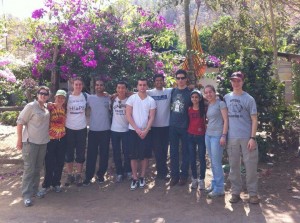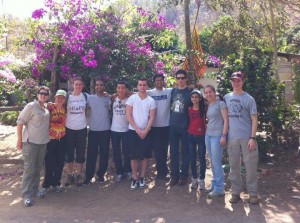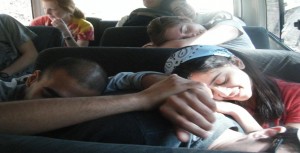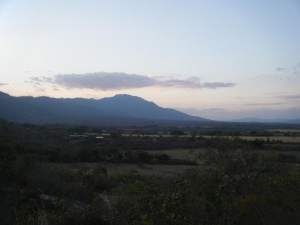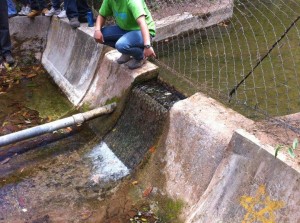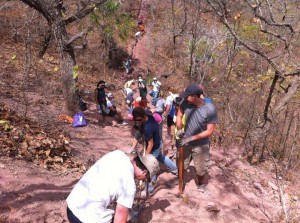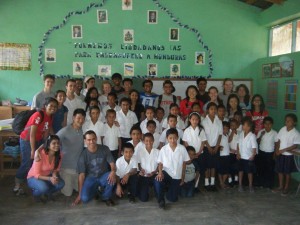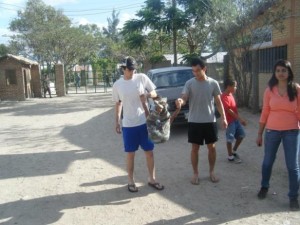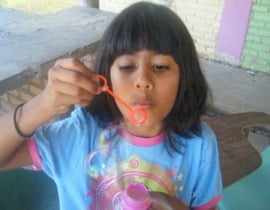Check out this detailed report from Global Water Brigaders at Washington University in St. Louis. If you’ve ever been curious to know what happens on a Water Brigade, this report is packed with detailed info on every aspect of a Water Brigade experience. Enjoy the first-hand testimonial, and thanks to the Brigaders at Washington University in St. Louis for sharing their experiences!
Global Water Brigades Summary of Events
Introduction: The Global Water Brigades at Washington University in St. Louis completed its first ever Spring Break service trip in Honduras under the leadership of two juniors, Abhi Kapuria and Kathan Chintamaneni on March 13-19, 2011. While there, a group of 11 students dug trenches and laid out pipeline to connect previously unavailable clean water sources at high mountain elevations to communities as far as 5 kilometers away. The primary communities of focus were El Canton and Las Cebeitas, both of which were approximately 2 hours distance away from the housing compound by jeep. In addition, students met with community leaders, visited local homes, and presented a clean water education program to a school of about 30 children between the 1st and 6th grades. Global Brigades was very well organized and left little to risk. Future ambitions of the group include doing an Energy brigade or making GB available over the summer, winter, and spring so that as many students that want to go can go.
The first ever Water Brigade to Honduras, WUSTL chapter: (Above Image at the base of the mountain in El Canton) Pictured L-R: Ali Hruschka, Jennifer Head, Anne Dohmen, Kathan Chintamaneni, William Cheng, Steven Miller, Abhi Kapuria, Matt Kroll, Shuby Priyadarshini, Liz Scoble, Chris Bell.
Description of Activities for Future Reference:
The only reasonably priced tickets leaving for the international airport in Tegucigalpa, Honduras (TGU) left out of Chicago’s O’Hare airport. In addition, the only flight that didn’t have a 14+ hour layover was at 5:00 in the morning. As a result, the official start time for the trip was 7:15 PM on Saturday, March 12th. We had given ourselves an extra hour in case there was a flat tire or anything unexpected and so that we had at least 3 hours for international check-in. Upon gathering at the clock tower, however, one of our brigaders reminded us that at 2:00AM, we were going to be experiencing ‘spring forward’. We had just lost our cushion. Immediately, we all threw our belongings into the 3 cars that would hold us and drove over 300 miles through the night. We parked our cars in long term parking and had previously agreed to split the cost of parking and gas between all brigaders. Upon reaching the airport, there was confusion about when the check-in would actually start but it turned out to be within a half hour of us waiting. Everything went smoothly until one of our brigaders got stopped for having a Brass Knuckles key chain and was almost held up by airport security. The guard, instead, realizing that this was a service trip, confiscated the weapon and let her through without calling the central officer. We lucked out.
After less than 8 hours of flight and layover time, we reached TGU. A global brigades program coordinator, Rachel Rimmerman, was waiting for us right outside customs with water in little baggies and enough lempiras (19 lemp = $1) so that everyone could get their own tortilla dish at an airport shop. At that time we were introduced to two of the Honduran drivers that would take us around for the rest of the week, Sr.’s Fausto and Mario. We waited at the airport for another hour for another brigade from Rutgers University to arrive but didn’t really expect to interact with them much.
Our first time in the ‘busito’, after a long night of traveling:
Once they arrived, our brigade piled into a 12 person ‘busito’ (little bus) with the luggage following in a jeep and began our 2 hour drive to the compound that we’d be staying at for the next week. At the end of a long dirt road that passed an orphanage (that we’d later have a chance to visit), was an immense fenced in housing unit that included a large cafeteria that could hold over 200 students, and a series of dormitories that jutted out of the mountainside. Innumerous stairs connected each of the dorms, a store, a fire pit, and seating areas, all overlooking an immensely beautiful view of the landscape of Honduras. There were four major dorms including one for staff. Inside each one, there were enough bunk beds to hold between 20-30 brigaders, 2 showers with running (non heated) water, 2 sinks, and a shower. The compound also had a generator that powered all of the lights, washing machines, and almost every other amenity you could want.
View from the middle elevation dormitory overlooking the mountains of Honduras.
We had just enough time to take showers and get ready for dinner in the Cantina. At the time, there were a few other brigades with us leaving fairly short lines in the large eating area. The food was always fresh and delicious and prepared by a full cooking staff. They had even made entire courses for vegetarians only so that everyone had plenty to eat. The staff graciously prepared meals like pasta, pancakes, local Honduran based beans, rice, and carne, chicken dinners, salads, and a variety of other meals every day. Even at the worksite, we were given a cooked meal of tortillas with plantains, beans, and cheese during lunch.
The first night, we met in a large group for the first time led by our coordinator, Rachel. This was our first taste of the other amazing students who had come from all over the country to spend their spring breaks doing service. That night we became acquainted with Rutgers, the University of Arizona, George Washington University, Indiana University, Texas A&M, USC, and others. To describe the relationship that developed over the next few days would do it a disservice. The friendships we made during this week were completely unexpected but really helped make the trip the incredible experience it really was. Overall, there were about 70-80 students on the Water Brigades and once the medical brigaders arrived the next day, the total was well over 130 students. We didn’t have too much interaction outside of our brigade not due to lack of opportunity, however.
On the first day out, we focused on getting an understanding of what the mission was all about. We drove for hours, climbed hundreds of meters up steep mountainsides to see how our efforts fit into the larger picture. We visited the input where water was funneled through a 3’’ pipe at max 90 gpm. The pipe led down to pressure breakers where we the engineers on our team performed a hydroelectric analysis that is still being compiled. The idea is to convert the pressure breakers into generation sites that can deliver electricity along with clean water on the same penstock. That research is ongoing but we’ve made significant progress in developing the idea. The uncovered pipe continued down hundreds more meters to a large 80,000 L distribution tank where the water was drip chlorinated and separated into three outbound pipes going to the three communities who were participating in the project. Lastly, we visited the smaller 10,000 L holding tank above El Canton. Each of these tanks took about 30 minutes of hiking to reach but every brigader was able to climb at their own pace and reach the site.
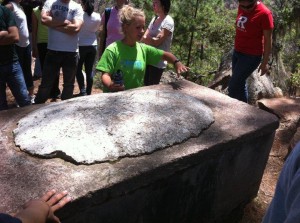 First of 2 Pressure Breakers at 500 m
First of 2 Pressure Breakers at 500 m
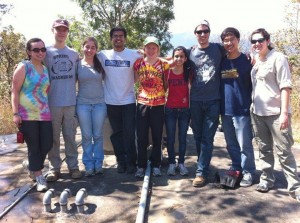
Large tank (~80K Liters)at 300 m
The next few days followed a similar pattern with us going in busitos at 7AM daily after breakfast to the base of a mountain where the communities were located, and then taking jeeps an hour up into the mountain, digging for about 3-4 hours, lunch, then digging for another hour or two before coming back to the compound around 6. We pick-axed and shoveled hand in hand with upwards to 30 Honduran men from the outlying area. Their efficiency and endurance was unbelievable. Even though this was our primary focus of the trip, working in rock and tough clay, in the heat, on an extremely steep mountain, we knew we had physically done little labor. As one of our coordinators, Ben, puts it, the kilometer of trench that we dug wasn’t the real impact. The impact comes from what we learned about the need for water and how much work is still left to be done in the world to improve conditions for people in need. The real impact comes from what we do after the trip, not what we did on the mountainside. On the last day of construction, the brigade went to the end of the second pressure breaker, laid down the PVC pipe, and covered up the 60cm deep trenches with dirt from around the area. It was an incredible experience to know that that segment of pipe was done and didn’t have to be worked on again and that we had helped.
Below: 80 students, 3 days, Pick-axe and Shovel
At night, we worked on an education program with Rutgers University that we would deliver on the last day before we headed out of Honduras. The 2-3 hour presentation included skits, songs, games, lessons, and prizes to help teach the kids about water sanitation and ways they could prevent themselves and their families from getting sick. These were the faces of the next generation of leaders in the community as the school in Las Cebeitas went up to the 6th grade. After the program, we visited the homes of several different community members. One of the community members was the local nurse for the entire community and was responsible for checking the weights of all of the children under 5. She had been given a manual and some instruction on how to take care of the people of her community and she also knew how to contact the doctor that lived 3 hours away walking distance.
Below: Wash U and Rutgers after the water sanitation presentation to the children of Las Cebeitas
The final installment of our program was a quick hour stay in the orphanage by our compound. Global Brigades had originated here a little over 7 years ago and has now developed into a powerhouse of change. We played with the children, learned about the customs of the ‘Tias’ (aunts, teachers) who took care of the children, and left gifts for them before returning to the compound for the last time.
Below: Wash U Brigaders at the Orphanage
After dinner, we spent the night dancing away at a cultural festival that was put on for the brigaders and packed to get ready to go home. We left for the airport at 3AM on Saturday and got back to Wash U after travelling for more than a full day at 7 AM that Sunday.

